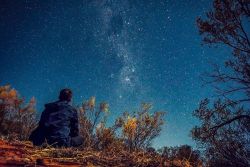A Magnetic Island
The Magnetic Island is located at the east coast of the southern North Queensland and belongs to the city area of Townsville. The island was discovered in 1770 by the British captain James Cook. When they sailed past, their compass went crazy, so Cook assumed that the island was made of magnetite-bearing rock and gave it the name Magnetic Island.
More than half of the island belongs to a National Park, which is mainly located in the steep, hilly interior and on the rugged north-west side. The island is a paradise for anglers and animal lovers, e.g. approximately 800 koalas live on the island.
Magnetic Island has about 2000 residents spread among four small villages. Nelly Bay is transforming into a destination for luxury tourists where as most budget travellers stay in Arcadia or Horseshoe Bay (where I also stayed).
Kangaroos & Kookaburra in the hostel
From Townsville I took the ferry to Magnetic Island which only takes around 45 minutes. The island is famous for the many wild animals you can see there. You can even encounter animals in the hostel. In my hostel, the YHA, I spotted Kookaburra, Kangaroos & Co. My hostel covered quite a big area, because it consisted of small independent huts for the backpackers and also had a big area for campers. But what was odd in the hostel was that there were nearly no utensils in the kitchen and you even had to borrow knives, forks and so on from the reception for a fee. Most likely, there was already too much theft.
It is advisable to take some food with you to the island, as the prices here are approximately twice as high as on the mainland.
Cute wallabies on the rocks
Early in the morning I drove to Geoffrey Bay to see rock wallabies. The small marsupials look like a dwarf version of a kangaroo. The bellies of the little animals were already quite taut, as they seem to get a lot of food from the tourists.
In several of the bays small coral reefs exist. Most of the coast is rather rocky with sandy beaches in the bays. The largest part of the island is covered by more or less light eucalyptus dry forests. In some valleys rainforest-like communities thrive. The rocky coastal ridges, on the other hand, are covered with lighter vegetation.
First time spotting a koala in the wild
On the island you can make many nice hikes. One of the hiking trails leads to an Australian military station that was built there to keep the Japanese from invading during World War II. The area, however, was spared from attacks eventually.
On the way back I met a wild koala for the first time. He was not really wild, though, as he was fast asleep, clasping his branch. Koalas sleep about 20 hours a day. No wonder then. Without the other hikers I would not have noticed the koala at all.
In the afternoon, bird feeding took place in the hostel. Two German friends from the Ruhrpott had persuaded me to join them. So we all stood there for minutes with bird food on our hands and waited until the little birds finally appeared. But they hesitated and hesitated. Finally the first bird had the courage and that was the sign for the other birds and afterwards they invaded us in droves to get the food out of our hands.
Nearly stepping on to snakes during hiking
In the evening we took part in a pub quiz, but unfortunately only ranked second. Because I liked the island so much I stayed another night. I undertook yet more hiking, this time to lonely beaches, one of them was even a nude beach, which would require quite a long walk over all kinds of stones. No beauty is basking in its full splendour there, there were only a handful of elderly naked people. Much more exciting there were the two snakes that scurried across the path in front of me while walking. Good that I did not step on them by mistake. It was not easy to distuingish the one snake from the soil as she had a brown color. Most of the snakes in Australia are poisonous, of the 10 most highly poisonous snakes in the world, the large majority hail from Australia.

